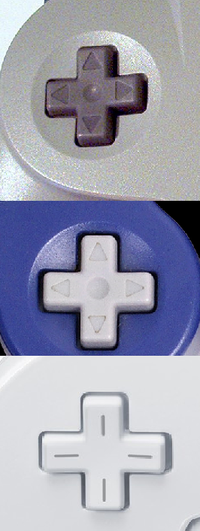| Welcome to SmashWiki! Log in or create an account and join the community, and don't forget to read this first! |
| Notices |
|---|
| The Skill parameter has been removed from Smasher infoboxes, and in its place are the new "Best historical ranking" and "Best tournament result" parameters. SmashWiki needs help adding these new parameters to Smasher infoboxes, refer to the guidelines here for what should be included in these new parameters. |
| When adding results to Smasher pages, include each tournament's entrant number in addition to the player's placement, and use the {{Trn}} template with the matching game specified. Please also fix old results on Smasher pages that do not abide to this standard. Refer to our Smasher article guidelines to see how results tables should be formatted. |
| Check out our project page for ongoing projects that SmashWiki needs help with. |
Directional pad: Difference between revisions
m (+Control Pad has been used at least since the GBA) |
m (I looked at Super Mario Bros. 3's manual (NES), and it was +Control Pad) |
||
| Line 3: | Line 3: | ||
[[File:DPad.png|thumb|The directional pad of the Nintendo 64 controller, the GameCube controller, and for both the Wii Remote and the Classic Controller.]] | [[File:DPad.png|thumb|The directional pad of the Nintendo 64 controller, the GameCube controller, and for both the Wii Remote and the Classic Controller.]] | ||
The '''directional pad''' (shortened '''d-pad''', officially | The '''directional pad''' (shortened '''d-pad''', officially '''+Control Pad''') refers to the grey, cross-shaped group of buttons on the left side of the [[GameCube controller|GameCube]] and [[Nintendo 64 controller|Nintendo 64]] [[controllers]], as well as the varyingly-colored group of buttons located on the [[Wii Remote]], [[Classic Controller]], [[Wii U GamePad]], [[Wii U Pro Controller]], and [[Nintendo 3DS]]. In ''[[Super Smash Bros.]]'', it serves no purpose other than menu navigation. In ''[[Super Smash Bros. Melee]]'', it also functions as menu navigation, but also has several other uses. Pressing up during a fight will make the player's character [[taunt]]. The d-pad is also used for activating Fox and Falco's [[Smash Taunt|secret taunts]] and [[Samus's Extended Grapple]]. In [[Camera Mode]] and the Trophy Gallery, the d-pad can be used to move the camera. In ''[[Super Smash Bros. Brawl]]'', it takes the role of the [[control stick]] when played on a Wiimote, and reprises it role of taunts for any other controller. When using the Wii Remote with the [[Nunchuk]], pressing upwards will make the character [[jump]], while pressing sideways will make the character [[grab]] in specified direction, and pressing down will let the character [[shield]]. | ||
When ''[[Super Smash Bros.]]'' is played on the [[Wii]] using a GameCube controller or Classic controller, it's analogous to the N64 controller's [[L button]], used for the character's [[taunt]]. | When ''[[Super Smash Bros.]]'' is played on the [[Wii]] using a GameCube controller or Classic controller, it's analogous to the N64 controller's [[L button]], used for the character's [[taunt]]. | ||
Revision as of 11:06, May 21, 2014
The directional pad (shortened d-pad, officially +Control Pad) refers to the grey, cross-shaped group of buttons on the left side of the GameCube and Nintendo 64 controllers, as well as the varyingly-colored group of buttons located on the Wii Remote, Classic Controller, Wii U GamePad, Wii U Pro Controller, and Nintendo 3DS. In Super Smash Bros., it serves no purpose other than menu navigation. In Super Smash Bros. Melee, it also functions as menu navigation, but also has several other uses. Pressing up during a fight will make the player's character taunt. The d-pad is also used for activating Fox and Falco's secret taunts and Samus's Extended Grapple. In Camera Mode and the Trophy Gallery, the d-pad can be used to move the camera. In Super Smash Bros. Brawl, it takes the role of the control stick when played on a Wiimote, and reprises it role of taunts for any other controller. When using the Wii Remote with the Nunchuk, pressing upwards will make the character jump, while pressing sideways will make the character grab in specified direction, and pressing down will let the character shield.
When Super Smash Bros. is played on the Wii using a GameCube controller or Classic controller, it's analogous to the N64 controller's L button, used for the character's taunt.
The directional pad also has uses not intended for regular gameplay: through the Debug Menu, it can be used to toggle the game mode and spawn items in-game, among other things.[1]
References
| hide Controllers and buttons | |
|---|---|
| Nintendo 64 controller | |
| GameCube controller | |
| Wii Remote (and Nunchuk) | |
| Classic Controller | L |
| Nintendo 3DS | |
| Wii U GamePad / Pro Controller | L |
| Joy-Con | |
| Switch Pro Controller | L |
| Third-party controllers | Hori Mini Pad · Arcade controller · Keyboard |
| Other | Smash Controller · Controller modification |

